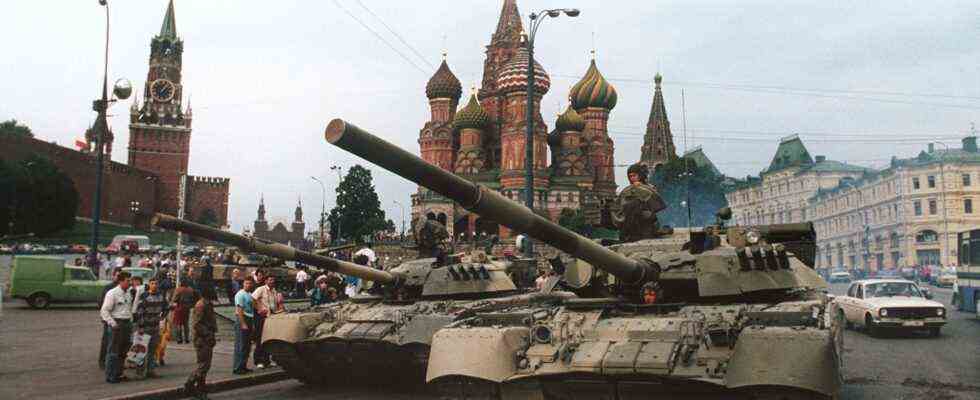Status: 08/19/2021 4:15 a.m.
Thirty years ago communist hardliners wanted to put an end to Gorbachev’s reforms. A coup was supposed to stop the collapse of the Soviet Union – and yet it caused its ultimate downfall.
Natalia holds out her arm and points to the bridge that leads across the Moskva to the White House, the seat of the Russian government. “Of course we were worried,” she says, “everyone was worried. Imagine: we’re sitting here now and suddenly a tank drives by.”
There, where the 70-year-old sits with her husband in the summer evening sun and remembers, surrounded by chic restaurants, an attempted coup took place 30 years ago. Which consequently heralded the end of the Soviet Union.
No fear of the army: Muscovites also opposed the putschists in front of the “White House”.
Image: picture alliance / dpa
There was a mood of crisis
On the morning of August 19, 1991, the spokesman for the news program “Vremya” announced on state television that, by decree, Vice-President Gennady Ivanovich Janayev would be head of state of the USSR from now on. Mikhail Sergejewitsch Gorbachev could no longer fulfill his function as president for health reasons.
The night before, a handful of conservative party functionaries had decided to put an end to Gorbachev’s drive for reform. At that time, the Soviet head of state was on vacation in Crimea, around 1,300 kilometers from Moscow. There he was arrested.
Gorbachev’s concept of glasnost and perestroika – transparency and restructuring of the Soviet state system – was celebrated by the West. It was the time of change and mutual rapprochement. In their own country, however, there was a mood of crisis and food shortages.
Flowers in cannon barrels
“There was perestroika, society was seething,” recalls Natalja, who was 40 years old at the time. But basically the situation was stable. “And suddenly something like that. It was a plot by a tiny section of the elite,” she says. Nobody knew about it, nobody was prepared for it. “In fact, the amazement was stronger than the fear.”
But when the tanks suddenly drove through Moscow, people also took to the streets. They erected barricades, formed human chains, stuck flowers in the cannon barrels and distributed homemade dumplings to the soldiers.
“That was when you thought, now or never,” says the historian and student at the time Alexej Merkisch. “Now I am free, now I get my rights, now I am no longer governed, I am not administered, but can also decide something myself.”
One of the moments that made the coup fail: Boris Yeltsin, then president of the Russian republic of the USSR, rises on August 19. 1991 on a tank and calls the Russians to a general strike.
Image: picture-alliance / dpa
A bloodless end
The soldiers fraternized with the demonstrators. After only three days, the attempted coup ended largely bloodless. Gorbachev returned to Moscow, but power had finally slipped away from him. Instead, Boris Yeltsin was seen as the new strong man – the President of Russia, who had also opposed the putschists.
Soon after, what the coup was supposed to prevent happened: the Soviet Union fell apart. Even today, Gorbachev is considered their gravedigger in the eyes of many ex-Soviet citizens. Vladimir Putin even described the collapse as the worst geopolitical catastrophe of the century.
30 years ago today: the beginning of the end of the Soviet Union
Martha Wilczynski, ARD Moscow, August 18, 2021 11:50 a.m.

